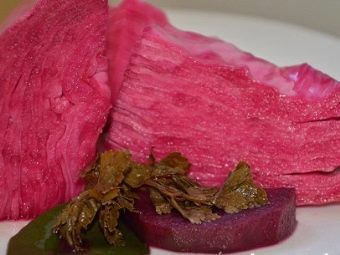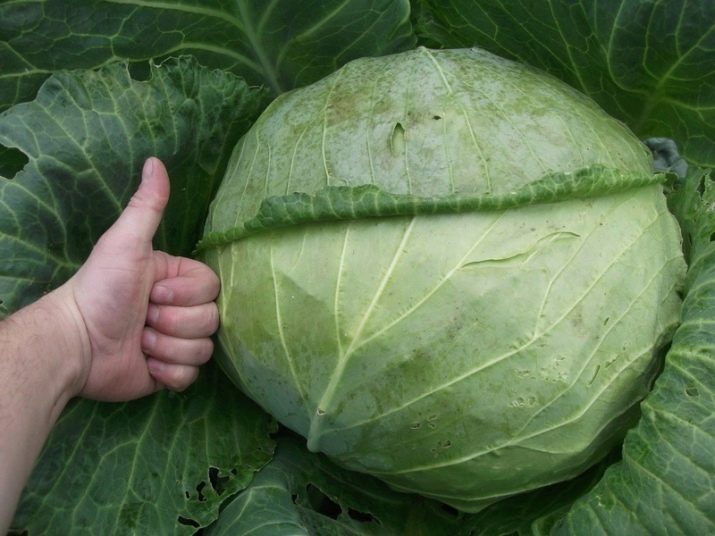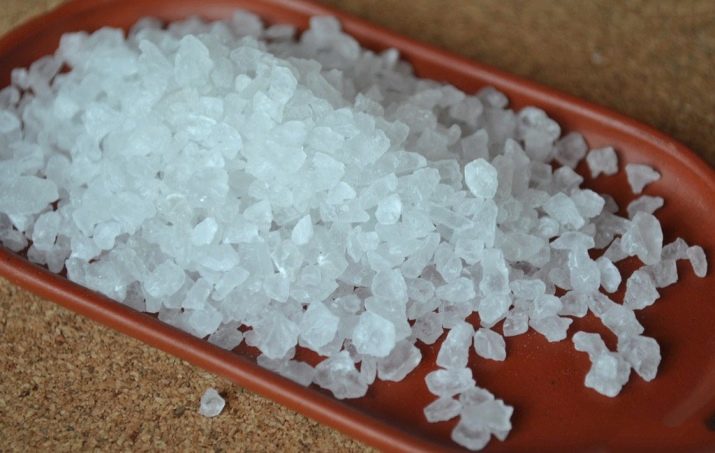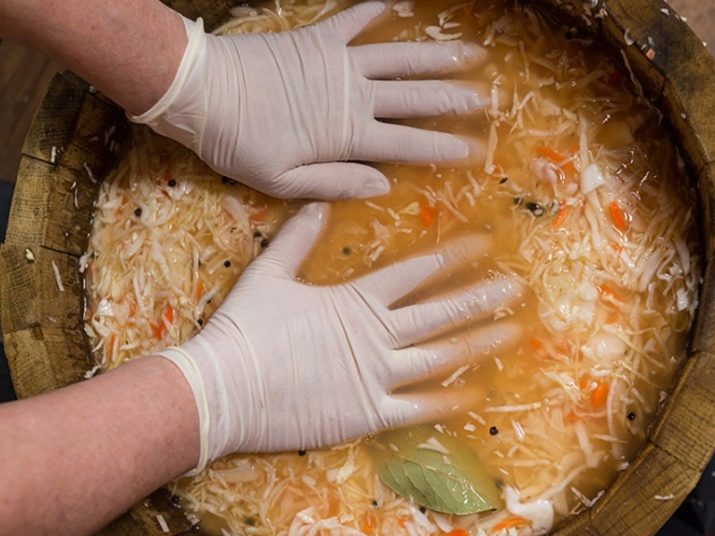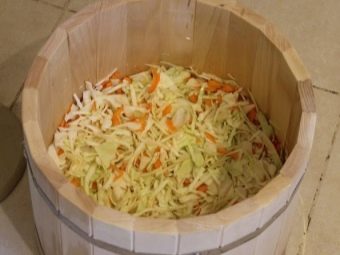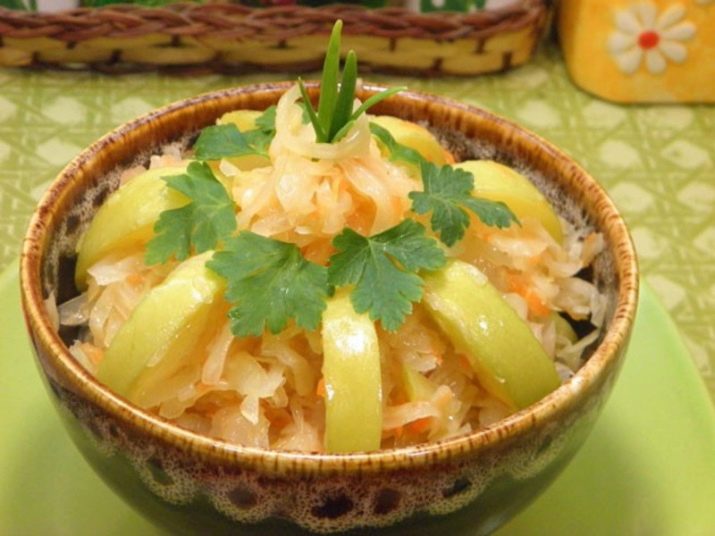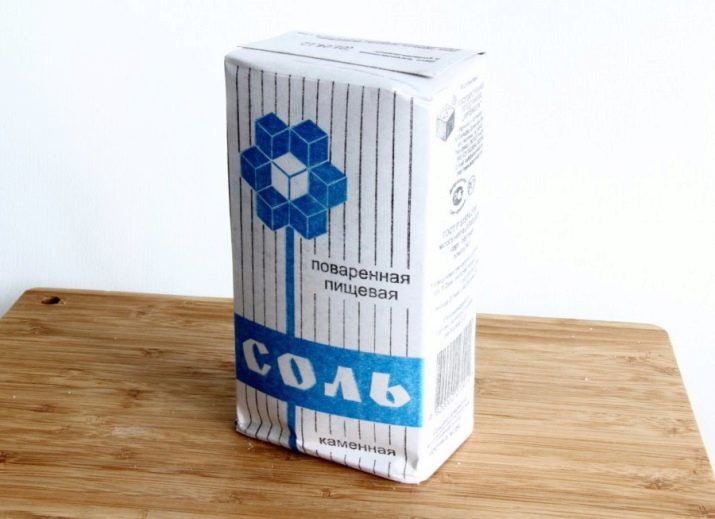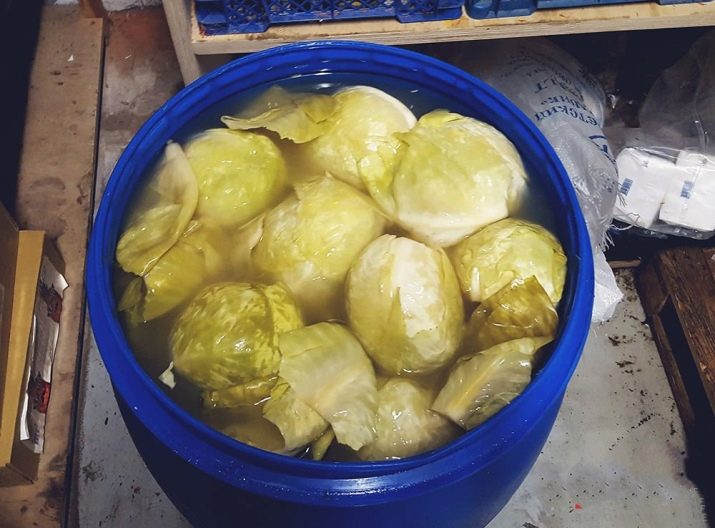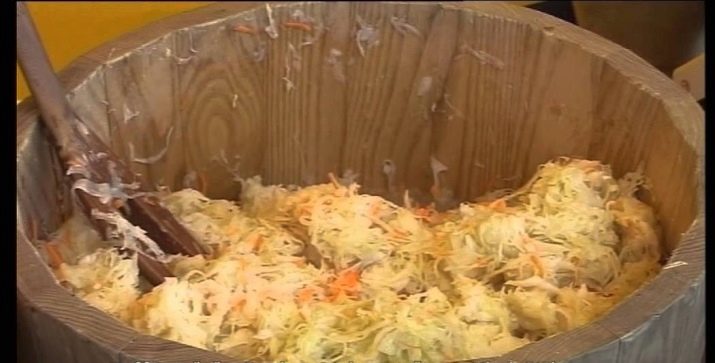How to cook sauerkraut?

From time immemorial cabbage was present on the Russian table - and raw, and sour. And the second much more often.Sauerkraut is not only tasty, it is also useful, has a pronounced healing effect, so everyone is recommended to include it in your diet.
Benefit and harm
There is an opinion that sour cabbage is a Russian national dish. But this is not quite the case - much earlier than the Russians, the indigenous people of Korea, Mongolia and China started souring this vegetable. This fact is historically proven - the very first references to the fermentation of this product were found in the annals relating to the construction of the Great Wall of China.
Nutritionists around the world do not get tired of "singing" a real ode to sour vegetables. It includes huge doses of ascorbic acid - in 100 g of the product is 15-20 mg of this vitamin, which plays the most important role in the functioning of the human body, strengthening its immunity, increasing resistance to viruses and colds.
The concentration in white cabbage and vitamin A, as well as vitamins B, K and U are great. Together, they have the most beneficial effect on the work of all vital human organs and systems, normalize nervous activity, strengthen heart muscle and vascular walls, improve digestion, have an antioxidant effect, increase visual acuity and regulate all metabolic processes.
Sauerkraut contains a large amount of iodine, because it is shown to all residents of megalopolises who are deficient in this trace element.
Cabbage fermentation occurs under the influence of special lactic acid bacteria that enter the human gastrointestinal tract, suppress pathogens and colonize the intestines with various bacteria that improve the condition of the body and eliminate the manifestations of dysbiosis.
Due to the lactic fermentation in sauerkraut, a large number of probiotics appear, because of which the product is compared with kefir in its effectiveness, but it also completely lacks kefir alcohols.
Sauerkraut is recommended to include in the daily diet for gastritis, including chronic. In addition, cabbage is indicated for patients with diabetes, because its use significantly reduces the level of glucose in the blood.
Brine from sauerkraut is very useful - it contains components that do not allow carbohydrates to transform into fat stores, which makes the product indispensable for patients with increased gastric acidity, as well as for all those who set themselves the task of getting rid of excess weight.
When liver pathologies, physicians advise drinking the brine left over from the cabbage during its fermentation, in combination with tomato juice in equal quantities. This drink must be drunk for quite a long time three times a day for half a glass.
Proven anthelmintic and antiparasitic properties of cabbage brine. For example, if you daily drink a third of a glass of pickle half an hour before meals, you can quickly get rid of Giardia in the liver.
Cabbage is also shown to pregnant women - it helps to significantly reduce all unpleasant manifestations of toxicosis. By the way, the representatives of the stronger sex should also pay attention to the pickled vegetables - it is believed that men who constantly eat sauerkraut, never have problems with potency.
Official medicine has confirmed that the use of cabbage can reduce the level of harmful cholesterol, and more recently the antitumor properties of the product have been identified, so it is widely recommended as a cancer prevention and also as an auxiliary product that enhances the effectiveness of treatment of this disease in the early stages. These studies were carried out in Finland on rodents - experts found that in hamsters fed with sauerkraut, the growth of malignant cells was suspended.
These data were confirmed by German scientists, who found that if you take cabbage at least a couple of times a week, you can significantly reduce the risk of developing oncological processes in the intestine.
However, you should not get involved in cabbage with kidney disease in the acute stage, and with pancreatitis it is better to reduce the use of acidic foods to a minimum. However, if the intake of the product could not be avoided, then immediately after that you should drink a glass of water, and preferably two or even three.
Subtleties choice of ingredients
Now that you have learned that sauerkraut is extremely useful and nutritious, you need to dwell on the features of its preparation. To make the dish really tasty and healthy, you need to choose the right ingredients.
Not every vegetable is suitable for pickling. Experienced housewives argue that It is advisable to use late and medium late cabbage varieties. Among them, Slava, Moscow Winter, Yuzhanka, Biryuchekutskaya, as well as Kolobok, Podarok, and Belorusskaya are particularly notable.
However, it is unlikely that there will be many sellers on the market who, without batting an eye, will answer what kind of white beauty they sell, and it’s unrealistic to find such information in stores. Therefore, it is better to determine the suitability of the plug by other related signs.
The most important thing when choosing cabbage is that the head must be dense and strong.
If it is deformed, soft or friable, it is better not to buy it, most likely you have before ripe cabbage, which will not give the proper tart taste and aroma.
The product should be fresh, not allowed the presence of rot and cracks. The stem must have a length of at least 2 cm, while it must be white at the cut point. If it is brownish, then you already have a lying down product and you should not buy it.
Stop your choice on a head of cabbage with green leaves. If they are not there, then there is a high probability that the cabbage was frost-bitten and the top leaves were simply cut. No need to buy too small forks. It is desirable that their weight was at least 1.5 kg, and it is best to choose a head of 3-4 kg. In this case, the waste is much less, and the yield of the final product, by contrast, is greater.
It is desirable that the heading is slightly flattened on top is an exceptional characteristic feature of some later varieties. However, if this is not the case, then this is not a reason to refuse to buy - and without this attribute you can find a good fork suitable for fermentation.
Popular Recipes
Classic option
Most often, cabbage is kvass according to the classic recipe, which was well known to our mothers and grandmothers, since it is based on Gostovskoy technology from 1965.
In fact, cooking sauerkraut is not difficult, but it is important to follow the recipe precisely, since skipping even one step will negate all your efforts and you will not get a tasty crunchy product.
First you need to clear the forks - to do this, remove green and dirty leaves from them, cut off the stalk, remove all frozen and deformed parts.
In the original recipe, cabbage is made with whole heads of cabbage, but since it is not possible to do this in the conditions of a city, it should be ground first.
The recipe includes carrots, it should also be thoroughly cleaned and grated on an ordinary coarse grater or one that is designed for Korean carrots.
Chopped vegetables should be poured on a flat, smooth surface, sprinkled with salt and intensively rubbed until the vegetables start to let the juice.
After that, you should be engaged in preparing the container - it is optimal to take a tub or enameled bulk container for this, the bottom should be laid out with whole leaves.
Salted cabbage should be shifted to the container with a layer of about 10-20 cm and thoroughly tamped, then add some more cabbage and press again.So repeat the manipulations until the workpiece is finished.
If you sour cabbage in a spacious container, then you can put 1-2 small forks in the center - in this case, in the winter, you can enjoy two kinds of cabbage.
After all the prepared vegetable mass is laid out, you should press the vegetables, cover with gauze or a clean cotton cloth, put a metal circle and press down with a yoke. At 3 kg of white cabbage, a three-liter glass jar filled to the top with water will be the best yoke. If all actions have been carried out correctly, then a day later a brine will form.
Salted cabbage should be shifted to the container with a layer of about 10-20 cm and thoroughly tamped, then add some more cabbage and press again. So repeat the manipulations until
Fermentation should take place at normal room temperature, it is not necessary to take the keg outside or, on the contrary, place it near the heating devices.
The first sign of the beginning of fermentation is the appearance of bubbles and foam - it should certainly be removed.
Then begins one of the most important stages. If you miss it, you just ruin the whole dish. Every day it is necessary to pierce the cabbage with a thin sharp wooden stick so that it reaches it to the very bottom - this is necessary in order to completely get rid of any gases with unpleasant odors. Otherwise, you will get a bitter and foul-smelling product.
When all the cabbage has settled, you should remove the press, remove the upper leaves that have become brown and carefully wash the circle first with hot water and soda, and then rinse with brine. After that, the napkin is squeezed, again put on the cabbage and once again put under the press.
This time it should be of less weight, the pressure should be such that the brine protrudes to the very edge of the circle. True cooked cabbage, as a rule, is distinguished by a yellow-amber shade. If at this moment the brine does not rise, then the pressure must be strengthened. The finished dish has a pleasant aroma and slightly sour taste. The product crunches on the teeth and has a pleasant aftertaste.
The dish should be stored in the refrigerator or any other cool place at a temperature of 0 to +5 degrees.
The recipe consisting of cabbage, as well as carrots and salt is considered a classic of the genre, but in order to diversify the taste, you can add a little seed of spicy herbs - dill and cumin, as well as cranberries, apples or laurel - it all depends on your own preferences.
Quick way
Sauerkraut can also be cooked much faster in a regular jar, and you can enjoy tasty and crispy cabbage on the third day. Of course, this recipe will not be a classic, but this method is very easy, and the taste of the finished delicacy is not inferior to cabbage, fermented in a keg.
The main secret here is that the pickle is prepared separately, but you should not be afraid of it - the recipe is quite simple and straightforward.
And, of course, only the marinade will come into contact with the cabbage, the same fermentation will start, just the process takes place in a more accelerated mode.
For one three-liter jar of sauerkraut we need:
- white cabbage - 2-3 kg;
- carrots - 2 pcs of medium size;
- Bay leaf;
- salt, spices to taste.
First you need to prepare the vegetables. To do this, they are thoroughly washed, cut off damaged areas and frozen places.
Then the cabbage must be finely chopped. Most often it is cut into strips, but cooking is allowed in small pieces or even leaves. After that, add finely chopped carrots to the cabbage and mix with the cabbage.
Prepared vegetables should be thoroughly washed so that the juice begins to stand out.
Following this, it is necessary to prepare the container or a deep pan, where it is necessary to lay out the cabbage-carrot harvesting for a while, and this should be done with little effort.It is in this container that cabbage will be fermented in the future, so you should add spices to taste.
While vegetables are letting the juice in, it is necessary to prepare a liter jar, pour it with cool water and pour 2 tbsp into it. spoons of salt. If desired, you can also make a couple of pinches of sugar, but this is optional.
Salt must necessarily be coarse, medium and fine is not suitable here. It should be stirred until complete dissolution, and then immediately pour the resulting solution on the cabbage.
It is necessary that they were filled with vegetables, so if the liquid is not enough, you should cook an additional portion of the marinade.
When water completely closes the cabbage with carrots, you need to take a lid, the diameter of which is smaller than the size of the container, then cover it with polyethylene and put it on top of the cabbage, and put the load on top. The ferment begins the very next day. At this point, it is necessary to pierce and push the cabbage with a wooden sharp stick and repeat these manipulations repeatedly during the day and until the end of ripening. Cabbage will be ready for use on the third day.
Keep in mind that under the pan in which you place the cabbage, you must put a bowl or other spacious containerSince during the fermentation the cabbage begins to produce additional juice, the marinade will become too much and it can “run away”.
This cabbage should be stored in the refrigerator, since it becomes rather acidic and too vigorous when warm.
Georgian
Quite piquant turns sauerkraut made in Georgian. For its preparation it is necessary to prepare the following ingredients:
- cabbage - 9-10 kg;
- small beet - 3-6 pieces;
- chili - 0.3-0.6 kg;
- celery greens - 0.5-0.8 kg;
- Lavrushka - 10-15 pieces;
- parsley - 100-150 g.
Cabbage forks need to be divided into 7-8 parts, then put into a prepared container and shift into large sliced beets, and pour in with herbs and pepper. When all the vegetables and spices are laid, you should pour the mixture with hot brine (for its preparation, 500-700 g of salt is dissolved in 10 liters of liquid, after which the billet is left in a warm place for a couple of days).
How to ferment for the winter?
Sauerkraut is considered one of the most simple, but at the same time quite tasty and delicious canned food for the winter, and there are many options for its preparation.
One of the most popular recipes is fermentation of cabbage in a glass jar. To do this, prepare:
- head of cabbage 2-2.3 kg;
- 2 medium carrots;
- 2 tbsp. l of salt;
- 1.5 Art. l refined sugar;
- 1.5 liters of water.
First you need to chop the cabbage into two halves and cut the stalk, then you need to chop it as small as possible and thinner.
It is advisable to take a young fresh cabbage - it will come out hard and crispy, but the old one has the peculiarity of being harsh.
Then you need to clean the carrots, preferably the last harvest - then it will be very fresh and always juicy. Orange vegetables are rubbed on a coarse grater or on a special grater for Korean carrots.
Vegetables need to be properly moved and “pozhamkat” hands so that they began to produce juice.
Immediately after this, you should take a can of 3 liters and rather tamp the prepared vegetable mixture there so that the maximum of the vegetable mixture and the minimum of air are in the can. To fill the container more tightly, it is worth using the available tools, for example, potato mash.
Separately, you need to cook a hot pickle. To do this, take 1-1.5 liters of water and pour 1.5 tbsp there. l sugar and 2 tbsp. l salt, all thoroughly mixed, so that the crystals are completely dissolved. To do this, you can stir the liquid with a spoon, or you can simply close the lid and shake vigorously until the final diffusion of all the dry ingredients.
Cooked marinade must pour vegetable seven to the maximum and leave in a warm place.After a day it will be possible to notice the appearance of bubbles - they will signal the beginning of the fermentation stage and the fermentation of the product.
After 2-4 days, when the fermentation process is complete, the cabbage should be rolled up with a sterilized lid and sent for long-term storage in a cool place.
Extremely tasty and extremely nutritious is sauerkraut with apples. This option causes persistent associations with Russian folk tales, in which cabbage is brewed in a barrel-tub near the stove, and even with bulk apples. To stock up for the winter fragrant cabbage, you need to cook:
- 20 kg of white cabbage;
- 2 kg of Antonovka apples or the like;
- 1.5-2 kg of carrots;
- salt at the rate of 60 -70 g for every 3 kg of vegetables.
Cabbage is quite finely cut, carrots are chopped into straw or tinder on a special grater. After that, you need to put all the vegetables in a fairly deep container, sprinkle with table salt and knead well until the juice begins to stand out. As soon as this happens, the mixture must be placed in a wooden barrel.
Separately, you should prepare the apples - for this they are cleared of seeds and cut into very thin slices, fall asleep in a barrel and slowly mixed so as not to mash and do not damage the soft fruit.
When all the components are ready, the keg should be covered with a lid, flattened with a stone or some other load and left at room temperature. After a short time, you will notice bubbles - do not be alarmed, so normally it should be. It is necessary to remove all the foam that forms, otherwise the products will become unpleasant both in taste and smell. Just as in the case of fast formulations, cabbage, which is brewed for the winter, should be periodically pierced with a wooden sharp stick for removing gases.
After 2-4 days, you can take off the press, close the keg and remove the cabbage to the loggia, balcony or cellar. There she should stand for a couple of weeks, after which she can be served.
Keep in mind, the longer the dish will be boiled, the more aromatic and tasty it will turn out.
Quite tasty get sauerkraut on the Serbian technology. The recipe here is quite easy, fast and extremely economical for the time spent - here you do not need to cut, chop and rub. However, the readiness will have to wait a little longer than in the traditional recipe, but the finished dish is definitely worth it.
By the way, it is possible to make stuffed cabbage from the cabbage obtained in this way. In Serbia, they are called Samra and are considered one of the country's national dishes.
All you need is cabbage and salt at the rate of 20 to 1.5. Carrots are not used here, and salt should be taken plain, not iodized.
Cabbage is thoroughly washed, cleaned from spoiled leaves and frost-bitten areas, after which the cobs are carefully cut out with a pyramid. Best for this use a long sharp knife. Keep in mind that it is unlikely that you will be able to take out the entire stump as a whole, but that's okay, it is enough to get rid of the top.
Heads of cabbage placed in a large tank or a capacious tub. Cut out the place covered with salt, in the same way come with all prepared heads and leave them for a day.
During this allotted time, the salt will absorb all the cabbage moisture and change a little in its structure.
The next day, each fork should be divided into 2 parts and put in a bowl or pan, pour cold water, press down and leave in a warm place for a couple of days. You can put there some apples or a handful of cranberries - then the cabbage will get a little sweet.
After a short time, the fermentation process starts in the pan - the liquid will begin to ferment, so after a couple of days, pour the solution into another container - in this case, the marinade is enriched with oxygen and the fermentation proceeds more rapidly. In the transfused brine again put the cabbage and again placed under pressure.All these manipulations must be repeated daily for 2 weeks. After that the cabbage is ready to eat.
If desired, part of the cabbage can be served immediately, and the rest is put into a keg, covered with a lid and sent to the basement for winter storage.
Useful tips
For those who do not have a large and roomy cellar at home, we can advise a rather unusual option for storing sauerkraut - in bags, however, for this, they must be pre-exhausted with a special device so that the cabbage is kept in vacuum.
In addition, experienced housewives give several recommendations for the preparation of sauerkraut, which will help to get a really tasty, tart and nutritious vegetable delicacy.
- For sauerkraut, you can take only wooden, as well as glass or clay containers, in extreme cases, cooking in food plastic containers is allowed. But from the use of aluminum or iron tanks should be abandoned - in the process of fermentation, the metal begins to oxidize and release harmful substances into the finished dish, and the taste of cabbage acquires a lasting metallic taste.
- The process of ripening due to the action of a special lactic acid bacteria. At the same time, it is very important to completely exclude bacteria of a different type from entering the tank - in this case, the vegetables may be pickled incorrectly. To avoid this effect, you should thoroughly clean and ventilate the room before starting the starter.
- For the preparation of sauerkraut is better to take the usual table salt of the largest grinding. If you use iodized, the cabbage comes out too soft and completely tasteless.
- Do not wash forks completely, it is better to limit the removal of the upper leaves and removal of damaged areas.
- For additional protection of the container against unwanted bacteria, it is better to lubricate the barrel or 3-liter jar with alcohol, vinegar, sunflower oil or honey.
- Folk signs insist that any fermentation is better to start on the rising moon. Experienced housewives have noticed that if the product is prepared for decreasing, then it turns out too "snotty."
- Do not try to knead the cabbage with salt too much - it should not be like a rag, it is enough to make 3-4 kneading movements. But tamp vegetables in a container should be as tight as possible. To do this, you should use ancillary products, and not rely on the strength of your hands alone.
- If you intend to preserve as many micronutrients and vitamins as possible, then do not shred cabbage too thin and finely. Keep in mind that the larger the vegetable is sliced, the more nutritional value will be in the finished dish.
- Cabbage for the winter should be stored in a cool dark place, but with positive temperatures. It is categorically not allowed to be in the cold - then it will simply become soft and lose its specific crunch.
- Do not forget to poke cabbage with a stick during the whole fermentation stage, and also remove the foam, otherwise the finished cabbage will become too bitter.
- Keep in mind that red cabbage for pickling at home is not suitable.
Bulgarian recipe for sauerkraut in the following video.


